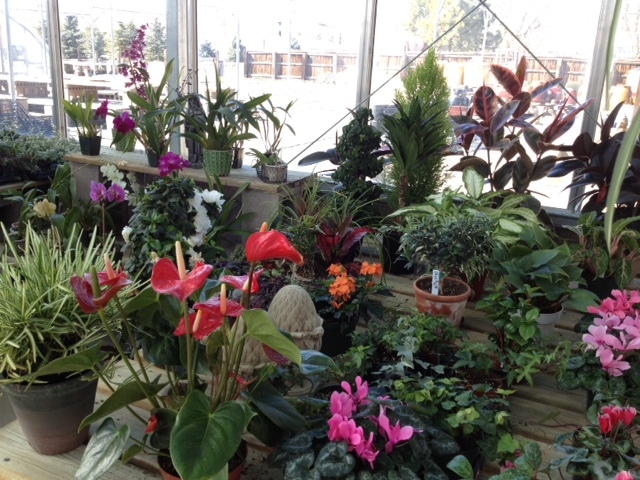The “secret” to success with taking care of house plants is to create the same ideal conditions as they would enjoy in their native habitat.
Indoor Plant Lighting
Wondering what plant to put where? Here’s an indoor plant lighting guide to four categories of light exposure for house plants.
Sunny (direct sun) location?
- Within 2 feet of a south- or southwest-facing window.
- Window sills flooded with sunlight.
- Succulents, Cactus, Ficus, Croton, Yucca
Bright (indirect sun) location?
- Within 4-5 feet of an east- or west-facing window.
- 3-5 feet from a window that faces south or southwest.
- Any place where the sun shines into a room with light colored walls for several hours.
- Shefflera, Aralia, Norfolk Pine, Cordyline, Dieffenbachia, Dracenea marg., Ferns, Ivy, Palms
Partially shaded (low light) location?
- An east-facing window where the morning sun shines into the room for only a few hours.
- At least 3-5 feet away from a window that faces south or southwest.
- Directly in front of a north-facing window gives a plant low-to-medium light intensity.
- Dracenea mass., Pothos, Spathiphyllum, Boston fern
Shady location?
- More than 6 feet away from a south- or southwest-facing window.
- Hallways, staircases, and corners of rooms.
- Sansieveria, Aglaonema, Philodendron
Watering
Poke your finger in the soil up to the first knuckle — it’s the surefire way to know if your plant needs watered. Does the soil feel damp? Don’t water. Does the soil feel dry? Water.
- Use water at room temperature (68° F/20° C).
- Water thoroughly, then allow the soil to dry out a bit before watering again.
- Don’t over-water — it’s the #1 reason house plants die.
Fertilizer
While light gives plants the energy they require, house plant fertilizer provides the nutrients they need to grow healthy and strong.
- Good potting mixes contain some nutrients to feed a repotted plant for several weeks.
- Use house plant fertilizer as recommended on the label. In low light conditions, use half that amount.
- Fertilizer is not a cure-all for an unhealthy plant. Never feed a plant that’s suffering from root damage, disease or insects.
Pinching
Using your thumb and forefinger to remove a tip of a stem is known as pinching a plant.
Pinching off growing tips will keep a fast-growing vine compact or help to maintain a plant’s bushy shape. When a young stem tip is pinched off, the plant will branch out and become bushier and fuller.
Always pinch above a node — the growing point where a leaf is attached. Cuts made here usually force branching below the cut.
Pinching works well for soft-stemmed plants such as coleus (shown at right) — as well as heartleaf philodendron, English ivy and pothos — that can grow long and leggy.
If a vine can’t be easily pinched off with your fingernail, use sharp pruners to avoid tearing a stem.
Re-Potting
The new pot should be no more than 2 inches wider at the rim — or 2 inches deeper — than the old pot. A pot that’s much larger gives the roots too much space to grow into. The top of the plant won’t grow until its roots begin to fill the container.
A too-large container will also hold too much water and can cause root rot. And while I’m on the subject — be sure to choose a container that has drainage holes to allow excess water to escape.
Basically, potting medium offers three things that a plant needs:
- Support (to keep the plant from falling over)
- It stores water and nutrients for the plant’s roots, and still provides good drainage so that the plant doesn’t get waterlogged
- Provides air circulation so that the roots can get oxygen
NASA Study – A Breath of Fresh Air
In the late ’80s, NASA and the Associated Landscape Contractors of America studied houseplants as a way to purify the air in space facilities. They found several plants that filter out common volatile organic compounds (VOCs). Lucky for us, the plants can also help clean indoor air on Earth, which is typically far more polluted than outdoor air. Other studies have since been published in the Journal of American Society of Horticultural Science, further proving the science.
Houseplants are awesome indoor air cleaners, but some of them are more effective than others at filtering out pollutants and toxic chemicals in the air. NASA’s Clean Air study found the plants below are effective at removing benzene, formaldehyde, and trichloroethylene, xylene, and ammonia from the air—chemicals that have been linked to health effects like headaches and eye irritation.
Look for these 10 houseplants at Creek Side Gardens:
Boston fern
Palms
Ficus plants
Dracenea plants
English Ivy
Spathiphyllum Peace Lily
Golden Pothos
Sanseveria Snake Plant
Aglaonema
Philodendron

